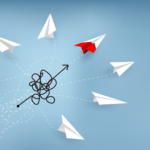In today’s fast-paced and rapidly evolving business landscape, innovation is no longer a luxury, but a necessity for survival. As organizations strive to stay ahead of the curve, they must constantly adapt and reinvent themselves to remain competitive.
However, the traditional approach to innovation, characterized by siloed thinking, incremental improvement, and a focus on short-term gains, is no longer sufficient to drive meaningful change. Intuition and trial and error, on the other hand get attention since they became must-have skills.
It’s time to revolutionize the way we approach innovation, and that’s where the TR-IN TRansform INnovation framework comes in. This ‘home-made with caring’ framework is designed to unlock the full potential of innovation, empowering organizations to think boldly, fast experiment, and transform industries.
By harnessing the power of TR-IN, businesses can break free from the constraints of conventional thinking and unleash a new era of innovation, growth, and success. TR-IN helps deploy transformative capabilities, and explore new ideas and concepts to unlock the full potential of innovation in your organization.
The TR-IN framework is designed to empower organizations to innovate at scale, speed, and agility, by providing a structured and systematic approach to innovation. By integrating specific tools and methodologies, the framework enables businesses to unlock new opportunities, identify unseen patterns, and create novel solutions that drive real impact. With its unique combination of human creativity, technological capabilities, and data-driven insights, the TR-IN framework is poised to revolutionize the way organizations approach innovation, and ultimately, transform the future of business.
The Era of Innovation: Why Traditional Methods Fall Short
In today’s fast-paced, rapidly evolving business landscape, innovation has become the lifeblood of organizations seeking to stay ahead of the curve. The traditional methods of innovation, however, are no longer sufficient to keep pace with the exponential rate of technological advancements and shifting customer needs. The tried-and-true approaches of the past, such as brainstorming sessions, focus groups, and SWOT analyses, are often too slow, too narrow, and too incremental to drive meaningful change.
In this era of digital disruption, businesses are faced with an unprecedented level of complexity, uncertainty, and competition. The traditional innovation playbook, which relies on linear thinking and siloed departments, is woefully inadequate to address the intricate, interconnected challenges of today’s business. It’s like trying to navigate a maze with a roadmap that’s outdated and incomplete.
Moreover, the traditional methods of innovation often fail to account for the human element, neglecting the emotional, social, and cultural nuances that drive customer behavior and decision-making. They also tend to prioritize short-term gains over long-term sustainability, ignoring the broader implications of innovation on the company, environment, and economy.
As a result, many organizations find themselves stuck in a cycle of incrementalism, churning out me-too products and services that fail to resonate with customers or drive meaningful growth. It’s time to revolutionize the way we approach innovation
Reasons of failure
One of the primary woe is the siloed approach to innovation, where separate departments and teams work in isolation, leading to a lack of cohesion and integration. This fragmented approach not only results in duplicated efforts but also fails to leverage the collective wisdom and expertise of the organization.
Another limitation is the reliance on traditional brainstorming or creative sessions, which often devolve into unstructured and unproductive meetings, lacking clear objectives and measurable outcomes. These sessions often prioritize quantity over quality, resulting in a plethora of ideas that lack feasibility, practicality, and alignment with the organization’s strategic goals.
Furthermore, traditional innovation approaches often focus on incremental improvements, rather than revolutionary breakthroughs. This incrementalism leads to a culture of complacency, where organizations settle for minor tweaks and adjustments, rather than striving for game-changing innovations that disrupt the status quo.
Lastly, the absence of a structured framework for innovation means that organizations often struggle to measure the effectiveness of their innovation efforts, making it difficult to allocate resources, prioritize initiatives, and drive meaningful change.
It is these limitations that the TR-IN Transformer L’Innovation Framework seeks to overcome, by providing a structured, collaborative, and outcome-driven approach to innovation that unleashes the full potential of organizations and drives transformative change.
What is TR-IN about?
A game-changing approach that empowers organizations to break free from the shackles of traditional thinking and unleash a tidal wave of creativity and innovation. This pioneering framework is specifically designed to transform the way businesses approach innovation, by providing a structured and systematic approach to ideation, experimentation, and implementation.
TR-IN Transformer L’INnovation Framework is built on the principles of collaboration, agility, and continuous learning, providing a roadmap for organizations to navigate the complexities of innovation and stay ahead of the curve.
By integrating the latest advances in augmented artificial intelligence, machine learning, NLP, and data analytics, this framework enables businesses to tap into the collective genius of their workforce, customers, and partners, and unlock new sources of value and growth.
At its core, the TR-IN is a dynamic, iterative process that fosters a culture of experimentation, risk-taking, and continuous improvement. By embracing this framework, organizations can overcome the barriers to innovation, accelerate the pace of change, and create a sustainable competitive advantage.
The Science Behind TR-IN
At the heart of the TR-IN lies a sophisticated science that empowers organizations to harness the full potential of innovation. By combining its cutting-edge models and tools with evidence based and curated data, TR-IN is able to analyze vast amounts of information, identify patterns, and generate novel ideas that would be impossible for humans to conceive alone.
The TR-IN algorithm is designed to mimic the human brain’s ability to think creatively, making connections between seemingly unrelated concepts and generating novel solutions. This is achieved through a complex process of data ingestion, where vast amounts of information are fed into the system, and then analyzed using advanced machine learning models.
The system’s neural network is trained on a massive dataset of innovation-related concepts, patents, and research papers, allowing it to learn from the collective knowledge and crowd wisdom
As the system processes this information, it generates a vast array of innovative ideas, which are then filtered and ranked based on their potential impact, feasibility, and relevance to the organization’s specific needs. The result is a curated list of breakthrough ideas that have the potential to disrupt industries, drive growth, and transform the future of organisation.
Meanwhile, the ML algorithms embedded in TR-IN enable the framework to learn and adapt in real-time, refining its understanding of the organization’s needs and challenges with each iteration. This creates a dynamic, iterative process that continually refines and improves the innovation process, ensuring that organizations are always pushing the boundaries.
TR-IN is able to accelerate the innovation process, reduce the risk of innovation failure, and increase the likelihood of successful outcomes.
Breaking Down the Components of TR-IN
At the heart of the TR-IN Framework lies a meticulously crafted architecture that enables organizations to harness the full potential of innovation. This framework is composed of 4 interconnected components, each playing a vital role in unlocking the transformative power of innovation.
Talent focuses on identifying, nurturing, and empowering individuals with the skills, creativity, and passion to drive innovation forward. This involves fostering a culture of collaboration, experimentation, and continuous learning, where innovators are encouraged to take risks, push boundaries, and challenge the status quo.
Radar represents the ability to scan the horizon, detecting emerging trends, technologies, and market shifts that can inform and inspire innovation. This involves developing a sophisticated sensing capability, leveraging advanced analytics, artificial intelligence, and human intelligence to stay ahead of the curve.
Ideation is where creativity meets feasibility, as individuals and teams come together to generate, develop, and refine innovative ideas. This involves creating a safe, stimulating environment that encourages wild thinking, prototyping, and experimentation, while also ensuring that ideas are aligned with business objectives and customer needs.
Navigation represents the critical connection between innovation and business strategy, ensuring that innovative ideas are integrated into the organization’s overall vision and roadmap. This involves establishing clear priorities, allocating resources, and defining key performance indicators to measure innovation’s impact on the business.
By breaking down the TR-IN framework into these six components, organizations can gain a deeper understanding of the complex dynamics involved in driving innovation, and develop a more systematic, structured approach to unlocking its transformative power.
Case Study: Successful Implementation of TR-IN in Energy Industry
In the realm of innovation, theories and frameworks are only as good as their real-world applications. Meet XYZ Corporation, a leading manufacturer of sustainable energy solutions, who embarked on a journey to revolutionize their innovation processes using TR-IN.
By integrating the TR-IN framework into their product development cycle, XYZ Corporation was able to tackle complex innovation challenges, foster a culture of experimentation, and drive meaningful breakthroughs. The results were nothing short of astonishing: a 30% reduction in time-to-market, a 25% increase in product innovation, and a 20% boost in customer satisfaction.
One of the key success factors was the ability of TR-IN to facilitate cross-functional collaboration, bringing together diverse teams of engineers, designers, and business stakeholders to co-create innovative solutions. The framework’s structured approach to innovation enabled the team to navigate the complexities of sustainable energy production, identify novel opportunities, and develop cutting-edge products that exceeded customer expectations.
Other Case Studies : TR-IN in action
We’ll explore a few compelling case studies that demonstrate the impact of TR-IN on driving innovation and growth in various industries.
From a multinational corporation that leveraged TR-IN to revamp its product development process, resulting in a 28% reduction in time-to-market and a 24% increase in customer satisfaction.
To a startup that utilized TR-IN to identify and capitalize on emerging market trends, yielding a 500% increase in revenue within a year – these case studies showcase the versatility and effectiveness of the TR-IN framework.
One notable example is a European automaker that was struggling to keep pace with the rapidly evolving electric vehicle market. By applying the TR-IN framework, they were able to identify and prioritize innovation opportunities, streamline their R&D process, and launch a new line of electric vehicles that exceeded customer expectations and set a new industry standard. The results were staggering: a 40% increase in sales, a 20% reduction in production costs, and a significant boost in brand reputation.
How TR-IN can transform industries: From Healthcare to Finance
The potential of TR-IN to transform industries is vast and far-reaching. By harnessing the power of the Framework, businesses and organizations can unlock new levels of innovation, efficiency, and growth.
In healthcare, TR-IN can help researchers and medical professionals uncover new insights and patterns in medical data, leading to breakthroughs in disease diagnosis and treatment. Imagine being able to analyze vast amounts of genomic data to identify new genetic markers for diseases, or using natural language processing to develop more accurate and personalized medical chatbots. With TR-IN, the possibilities for improving healthcare outcomes are endless.
In the finance sector, TR-IN can help banks and financial institutions automate complex tasks, such as risk assessment and compliance, freeing up human capital to focus on higher-value tasks like strategy and innovation. By applying TR-IN to large datasets, financial institutions can identify hidden patterns and trends, enabling them to make more informed investment decisions and mitigate risk.
In the fintech space, companies have leveraged TR-IN to develop cutting-edge payment systems, while in the education sector, it has enabled the creation of personalized learning platforms that cater to individual students’ needs.
One notable example is a leading retail company that utilized the TR-IN framework to develop an AI-driven customer service chatbot. This innovative solution not only improved customer satisfaction ratings but also reduced operational costs by a significant margin.
Another example is a sustainability-focused startup that employed the TR-IN framework to design a novel waste management system, resulting in a significant reduction in carbon emissions.
But the impact of TR-IN doesn’t stop there. It can also be applied to industries such as education, transportation, and energy, to name a few. Whether it’s developing more personalized and effective learning platforms, optimizing logistics and supply chain management, or improving the efficiency of renewable energy systems, the potential of TR-IN to drive innovation and transformation is limitless. As businesses and organizations begin to harness the power of TR-IN, we can expect to see a fundamental shift in the way industries operate, and a new era of innovation and growth.
Enhancing Creativity and Ideation
The spark of creativity is the lifeblood of innovation, and the TR-IN framework is designed to fan the flames of imagination, empowering individuals and teams to think outside the box and generate novel solutions. By harnessing the power of TR-IN, organizations can unlock the full potential of their creative capital, fostering a culture of innovation that drives growth, differentiation, and success.
Within the TR-IN framework, ideation is elevated to an art form, where diverse perspectives and expertise converge to produce novel combinations of ideas. The structured approach to creativity and ideation encourages wild and ambitious thinking, while also providing a practical roadmap for turning abstract concepts into tangible, real-world solutions. By leveraging the transformative power of TR-IN, teams can break free from the constraints of conventional thinking, embracing a culture of experimentation and calculated risk-taking that yields breakthrough innovations.
As a result, organizations can expect to see a surge in creative output, as TR-IN’s unique blend of artificial intelligence, machine learning, and human-centered design principles converges to produce novel solutions that address real-world problems. By integrating TR-IN into their innovation ecosystem, businesses can unlock new revenue streams, disrupt markets, and create new opportunities for growth and expansion.
How TR-IN Fosters Collaboration and Cross-Functional Teams
In the pursuit of innovation, collaboration and cross-functional teams are essential components of a successful strategy. However, bridging the gap between disparate teams and fostering a culture of collaboration can be a daunting task. This is where the TR-IN comes into play. By providing a shared language and framework, TR-IN empowers teams to work together seamlessly, transcending traditional silos and boundaries.
With TR-IN, teams can collectively identify areas of innovation, prioritize efforts, and allocate resources more effectively. The framework’s structured approach enables teams to speak the same language, ensuring that everyone is on the same page, from ideation to implementation. This, in turn, facilitates the creation of high-performing, cross-functional teams that can tackle complex innovation challenges with ease.
Moreover, TR-IN’s emphasis on collaboration and co-creation encourages active participation from all stakeholders, including customers, partners, and employees. This inclusive approach not only leads to more innovative solutions but also fosters a sense of ownership and accountability among team members. As a result, organizations can accelerate their innovation journey, drive business growth, and stay ahead of the competition. By harnessing the power of TR-IN, businesses can unlock the full potential of their teams, unleashing a culture of innovation that permeates every aspect of the organization.
Overcoming Common Challenges and Obstacles with TR-IN
One of the most significant advantages of the TR-IN Tframework is its ability to overcome common challenges and obstacles that often hinder innovation. With its structured approach, TR-IN empowers organizations to navigate the complexities of innovation, avoiding the pitfalls that can derail even the most well-intentioned initiatives.
In today’s fast-paced and rapidly changing business landscape, innovation is no longer a nicety, but a necessity. However, the reality is that many organizations struggle to innovate effectively, often due to internal barriers, limited resources, and a lack of clarity on how to drive meaningful change. TR-IN tackles these challenges head-on, providing a clear roadmap for innovation success.
By leveraging TR-IN framework, organizations can overcome common obstacles such as siloed thinking, inadequate resources, and a lack of stakeholder buy-in. TR-IN’s structured approach ensures that all stakeholders are aligned and working towards a common goal, fostering a culture of collaboration and innovation.
Additionally, TR-IN’s emphasis on data-driven decision making and iterative testing helps to mitigate risk, ensuring that innovation efforts are focused on high-impact initiatives that drive real business results. By embracing the TR-IN framework, organizations can unlock their full innovation potential.
The Future of Innovation
The future of innovation lies in the ability to harness the collective genius of diverse teams, to iterate rapidly, and to experiment fearlessly. TR-IN is making this vision a reality by providing a structured approach to innovation that is both agile and adaptable.
As the TR-IN framework continues to evolve, we can expect to see a fundamental shift in the way innovation is approached. No longer will innovation be the domain of a select few; instead, it will become a core capability that is embedded in the DNA of organizations. The future of innovation is bright, and TR-IN is leading the charge. With its transformative power, we can expect to see a new wave of innovation that will change the world for the better.
Getting Started with TR-IN: A Step-by-Step Guide
Embarking on a transformative journey with TR-IN is an exciting venture, and getting started can seem daunting. But fear not, for we’ve broken down the process into a clear, step-by-step guide to help you navigate the implementation of this revolutionary framework.
Begin by assembling a dedicated team of innovators, comprising diverse stakeholders from across your organization. This dream team will spearhead the TR-IN initiative, fostering a culture of collaboration and creativity.
Next, conduct a thorough analysis of your organization’s current innovation landscape, identifying areas ripe for disruption and opportunities to leverage the TR-IN framework. This will enable you to pinpoint the most impactful applications of TR-IN, maximizing its potential to drive meaningful change.
With your team and landscape analysis in place, it’s time to delve into the heart of TR-IN: the 4 interconnected pillars of Transformation, Reinvention, Innovation, and Nurture. Through a series of interactive workshops and immersive training sessions, equip your team with the knowledge and skills necessary to master each pillar, ensuring a deep understanding of how they intersect and amplify one another.
TR-IN is not a one-size-fits-all solution. Be prepared to adapt, iterate, and refine your approach as you navigate the complexities of innovation. With patience, persistence, and a commitment to excellence, you’ll be unlocking the full potential of TR-IN in no time, unleashing a wave of innovation that will revolutionize your organization
Conclusion: Unlocking the Potential
TR-IN framework is a game-changer for organizations seeking to revolutionize their innovation capabilities. By harnessing the power of artificial intelligence, machine learning, and human-centered design, this framework provides a structured approach to innovation that is both scalable and sustainable. As we move forward in this rapidly changing landscape, it’s essential for organizations to stay ahead of the curve and leverage the latest advancements in innovation methodologies.
Remember, the future of innovation is not just about incremental improvements, but about bold, transformative leaps forward. With TR-IN, you now have the tools to make that vision a reality. The revolution starts now – are you ready to join the movement?












About The Author
Janus Andersen
Advice on Strategy | Innovation | Transformation | Leadership Helping growth strategies and M&A transactions for 20 years